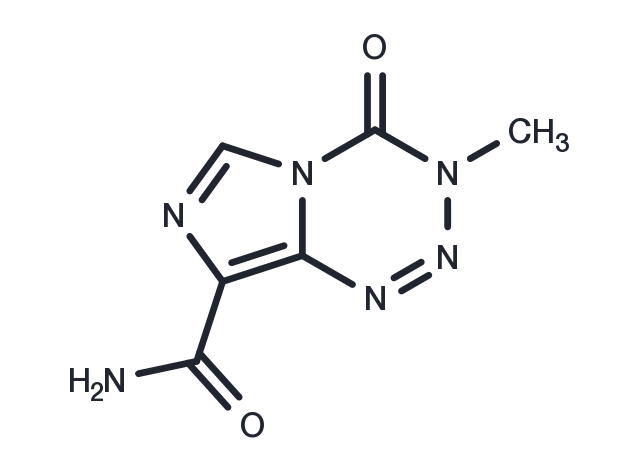keep away from direct sunlight
Powder: -20°C for 3 years | In solvent: -80°C for 1 year
Size : 50mg
Temozolomide (TMZ) is a DNA alkylating agent with blood-brain barrier permeability and oral activity. Temozolomide has antitumor activity and antiangiogenic activity, and also induces apoptosis and autophagy.

| Description | Temozolomide (TMZ) is a DNA alkylating agent with blood-brain barrier permeability and oral activity. Temozolomide has antitumor activity and antiangiogenic activity, and also induces apoptosis and autophagy. |
| In vitro | METHODS: Melanoma cells SK-mel-28, MM200, IgR3, Mel-FH were treated with Temozolomide (0-500 μM) for 72 h. Cell viability was examined using MTT. RESULTS: The p53 status and MGMT expression levels were correlated with the sensitivity of Temozolomide. MM200 and IgR3 (expressing wild-type p53 and low MGMT levels) showed comparable sensitivity to Temozolomide, with IC50 values of 23 and 22 μM, respectively, whereas SK mel-28 and Mel-FH (mutant-type p53 and high MGMT level) were resistant with IC50 values >256 and >247 μM. [1] METHODS: Melanoma cells MM200 and IgR3 were treated with Temozolomide (100 μM) for 24-72 h. The cell cycle was examined by Flow Cytometry. RESULTS: Temozolomide induced G2/M cell cycle arrest in MM200 and IgR3 cells. [1] METHODS: Human glioma cells U118 were treated with Temozolomide (250-500 μM) for 3-48 h. The m5C level in DNA was measured. RESULTS: The response of U118 cells to Temozolomide depends on the concentration and time of the reaction. The amount of m5C in DNA increased significantly within a short period of time after Temozolomide treatment. m5C(R) reached the highest level after 24 h of treatment with 500 μM Temozolomide. [2] |
| In vivo | METHODS: To assay antitumor activity in vivo, Temozolomide (68 mg/kg by gavage) and AG-014699 (1 mg/kg by intraperitoneal injection) were administered intraperitoneally to CD1 nu/nu mice harboring medulloblastomas D425Med, D283Med, or D384Med once daily for five days. RESULTS: AG-014699 enhanced the efficacy of Temozolomide in an in vivo model of medulloblastoma. [3] METHODS: To assay antitumor activity in vivo, Temozolomide (0.9 mg/kg orally once daily) and Aldox (16 mg/kg intravenously once weekly) were administered to Foxn1 nude mice bearing human glioblastoma U87MG once daily for five weeks. RESULTS: Combined treatment with Temozolomide and AldoxAldo induced significant tumor volume suppression and increased survival. [4] |
| Cell Research | Cell lines exposed to TMZ (with or without 5-Aza or O6-BG pre-treatment) were grown in 24-well plates under standard culture conditions for 6 days. Cytotoxicity was determined using the sulphorhodamine-B (SRB) method. Briefly, the cells were fixed with 10% trichloroacetic acid for 20 min at 4°C then washed three times with water. After 24 hours, cells were stained for 30 min at room temperature with 0.4% SRB dissolved in 1% acetic acid and then washed three times with 1% acetic acid. The plates were air-dried and the dye solubilized with 300 ml/well of 10 mM Tris base (pH 10.5) for 10 min on a shaker. The optical density of each well was measured spectrophotometrically using a Titertek multiscan colorimeter at 492 nm [2]. |
| Animal Research | TZM was dissolved in dimethyl-sulfoxide (40 mg/mL), diluted in saline (5 mg/mL), and administered intraperitoneally on day 2 after tumor injection at 100 mg/kg or 200 mg/kg, doses commonly used for in vivo preclinical studies.15-17 Because cytotoxicity induced by TZM and PARP inhibitors can be improved by fractionated modality of treatment,9 in selected groups a total dose of 200 mg/kg TZM was divided in 2 doses of 100 mg/kg given on days 2 and 3. NU1025 was dissolved in polyethylene glycol-400 (40% in saline) and was injected intracranially at the maximal deliverable dose (1 mg/mouse, 0.03 mL) or, in selected groups, intraperitoneally (0.3 mL) on day 2 after tumor challenge, 1 hour before TZM administration. Control mice were injected with drug vehicles [4]. |
| Synonyms | NSC 362856, TZM, CCRG 81045, TMZ |
| Molecular Weight | 194.15 |
| Formula | C6H6N6O2 |
| CAS No. | 85622-93-1 |
keep away from direct sunlight
Powder: -20°C for 3 years | In solvent: -80°C for 1 year
PBS: 5 mg/mL (25.75 mM), Sonification is recommended
DMSO: 28.83mg/ml (200 mM)